With its mysterious, stoic moai watching over the island and craterous, seemingly barren landscapes that hint at a turbid, fascinating history, Easter Island** (aka Isla de Pascua as it’s known in Spanish or Rapa Nui as is its local name) captivates most travelers.
The idea of visiting the staggeringly remote Easter Island is one that drives many tourists to Chile, making it one of the country’s most popular things to do.
But it’s a notoriously expensive South American destination and one that is commonly believed to be difficult to visit without spending a fortune.
Luckily, this isn’t true.
As I found out on my trip to Easter Island, there are plenty of ways that you can explore this 163 square kilometer island without forking out thousands of dollars.
Know before you go: Easter Island
COVID-19 update: Rapa Nui/Easter Island reopened to visitors on August 5th, 2022. Entry requirements include proof of vaccination, a single entry form, proof of reservation with a hotel or tour operator, plus various other requirements. Find the full list here.
Why you should add Easter Island to your itinerary
Easter Island, or Rapa Nui as the locals know it, is a remote island located in the South Pacific Ocean, 3,500km from mainland Chile (or a five+ hour flight) and visiting is definitely one of the things you should do in Chile.
It’s Chile’s most enigmatic island. The story of a civilization driven to the brink of extinction continues to attract visitors intrigued by the mystery that surrounds the 887 moai, the famed monolithic human figures that were carved between 1,250 AD and 1,500 AD from volcanic tuffstone monoliths and populate the island’s coasts.
The moai are easily the island’s biggest attraction and have the most fascinating histories. One of my guides even pointed out a moai on one of the most visited ahu, the restored Ahu Tongariki, and told me had been carved to represent one of his ancestors.
For others, the appeal of Rapa Nui lies in its distance from the rest of the world. It is the most remote inhabited island on earth; its nearest neighbors are on Pitcairn Island, 2,000 kilometers (1242 miles) northwest.
But what is the cultural significance of the moai?
Believed to have been carved by inhabitants of the island between 1250 and 1500, the moai represent tribal chiefs and are symbolic of both political and religious power.
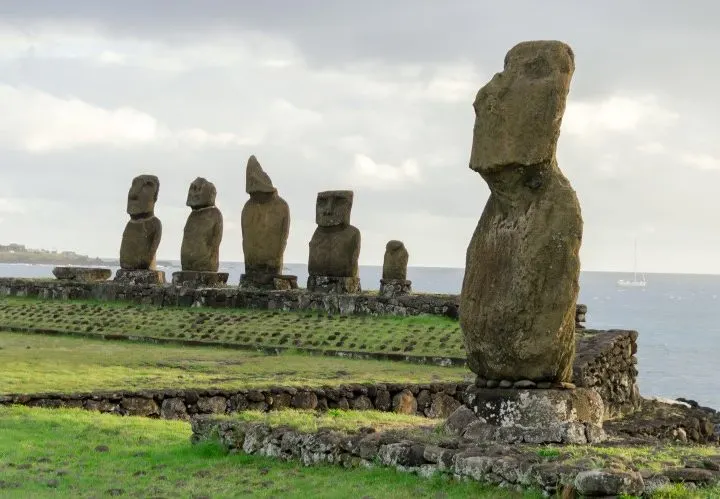
When a chief passed away, they would be buried or cremated under the ahu, the platform on which the moai sat, and it was believed that their spirits were housed in their unique moai. With the chief becoming a divine presence in death, the moai provided a spiritual force for natives, serving and guiding those who were left behind.
To this day, the moai hold great significance to locals, and it is forbidden to touch them.
After a day of visiting the moai figures, keep your eyes peeled for petroglyphs – these rock carvings may be a little trickier to find compared to the moai, but are still well worth trying to locate.
Yes, Machu Picchu is incredible, but I do think Chile has a punt at being named one of the best South American countries for archeology – and living history, too.
Where exactly is Easter Island?
Easter Island is located in the Pacific Ocean and the nearest land masses are the Pitcairn Islands, 1,931 kilometers west.
However, Easter Island officially belongs to Chile, even though it lies exactly 3,746 kilometers west of the country.
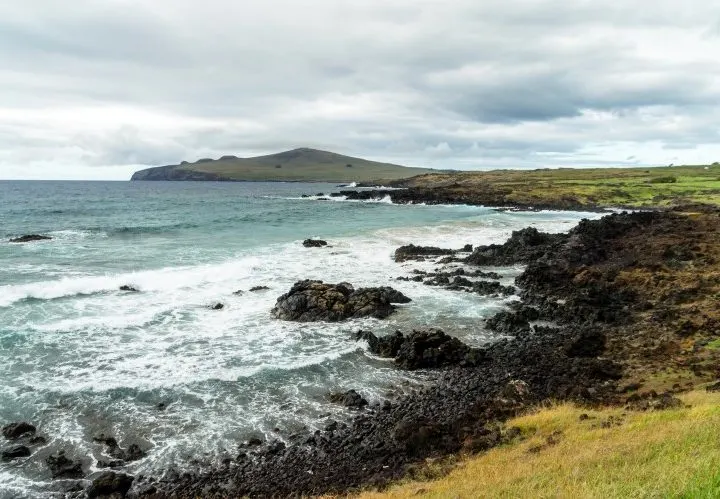
Strangely enough, the islands are part of the Valparaiso Region, even though they are geographically closer to the Atacama Region if you were to draw a line due west to mainland Chile.
Planning Your Trip to Chile?
Save time, stress & money with a customized travel itinerary planned for you by a Chile expert
Do people still live on Easter Island?
Yes, Easter Island is still inhabited! Using radiocarbon dating, archaeologists now believe that the first colonizers of the island, explorers from Polynesia, arrived on Easter Island sometime around 1,200 AD.
These initial settlers organized themselves into mata or tribes and survived through innovative agricultural practices until the arrival of the European colonizers on Easter Sunday in the year 1722 – a date that explains the island’s English – and colonial – name.
Although estimates for the size of the population on Easter Island range wildly, from 1,000 to 17,500, what is known is that slave raids by Spanish-owned Peru and the introduction of diseases nearly exterminated the entire population of the island in the 19th century.
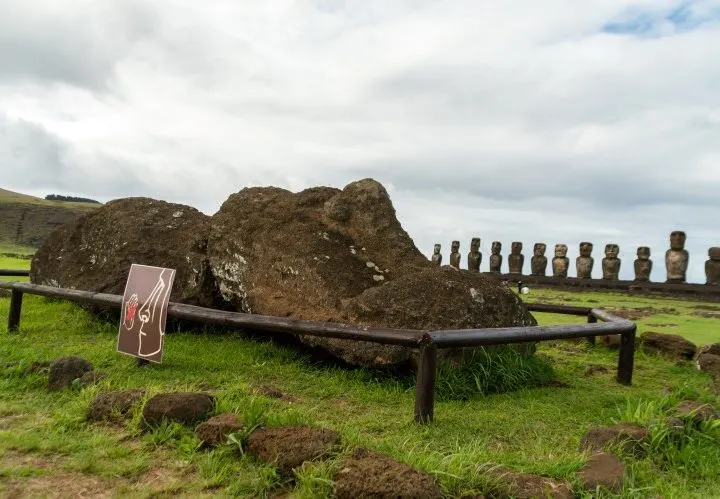
At present, population levels are around 7,000, and law changes have been introduced to make it harder for foreigners and Chileans to move to the island due to concerns about population increases and the environmental consequences of this.
When I visited Easter Island, the most fascinating part of my trip was the chance to talk to the local Rapanui people.
Misconceptions have long plagued the history of this Pacific Island, and arguably the best way to learn about the real history of its people is by talking to them.
Top Easter Island travel tip: The island and its people are notoriously closed to foreigners and I certainly found it difficult to get residents to talk to me. However, most guides are very welcoming and really happy to talk if you show interest in the Rapa Nui culture. Spanish goes a long way here as few people speak much English.
How to get to Easter Island
The initial act of getting to Easter Island will be the biggest expense of your trip.
Although the romanticized idea still exists among travelers that it’s possible to travel to Easter Island aboard the Aquiles, a vessel operated by the Chilean Navy, it actually only departs around twice a year from Valparaíso and is almost exclusively reserved for Naval personnel and other people on official business.
The journey to Easter Island aboard this ship also takes seven days through open waters – so it’s only really suited to those with particularly strong sea legs.
Another way to reach Easter Island is with a cruise, but you’re looking at paying at least a few thousand dollars for cruises that merely take you from Valparaiso to the island or vice versa.
As a result, the only practical way of traveling to Easter Island is by plane. Be aware that flights are regularly delayed due to high winds, meaning you may find yourself waiting around in Santiago or on the island itself for an additional day.
Top Easter Island travel tip: Make sure to book a window seat on the left-hand side of the plane on the way there and back for the best views. You fly right over the island and make a turn southeast across the ocean to finally land from the west at Mataveri International Airport, the only airport on Easter Island. When you leave, you take off east, so again you get views right across the island from the left-hand window.
How to fly to Easter Island
LATAM is the only airline that flies to Easter Island. Their planes depart from Santiago with a flight time of around six hours on the outward journey.
On the way back to Santiago, the flight time is only four and a half hours thanks to prevailing winds.
Getting to Easter Island from Chile is relatively straightforward as these flights leave up to three times daily in high season (October through April) and up to twice daily (Wednesdays and Sundays) in low season (May through September).
Flight schedules are slowly returning to pre-pandemic levels, with lots of flights now available (a few times per week from early December and then close to daily going forwards).
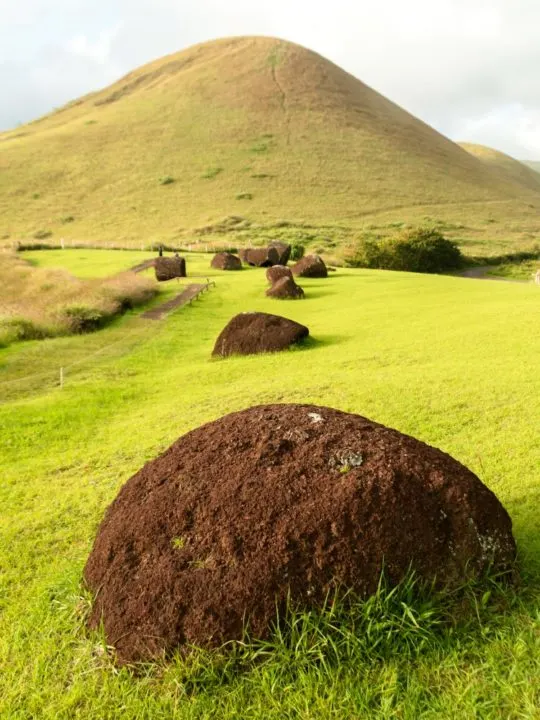
There is also one weekly flight from Papeete (Tahiti) in French Polynesia to Easter Island on Tuesdays (returning the following Monday). For this flight, you can expect to pay around $700,000 CLP ($1,050 USD) return.
Easter Island plane tickets can be horribly expensive, particularly during high season, although January and February, in particular, see elevated prices as these are the school holiday months and prime vacation time for Chileans.
However, cheap flights to Easter Island from Santiago are possible, particularly if you can be flexible with your dates.
When I visited in June (admittedly the very low season but still a good time to go to Easter Island as I’ll discuss below), I snagged flights for $217,000 CLP ($332 USD), a practically unheard-of price.
It’s unlikely you’ll get flights to Easter Island anywhere within this price range in high season, however, it isn’t always the case that you’ll be paying upwards of $800,000 CLP ($1,200 USD).
How to secure cheap flights to Rapa Nui
Often the best way to get cheap flights is to book well in advance and this can certainly be the case for Easter Island.
However, if you’re flexible and not quite sure of the exact dates you plan to be traveling, the cheapest way to get to Easter Island is by downloading the free app Hopper.
I love this app – mostly because it’s helped me to get extremely cheap flights on a number of occasions.
All you need to do is input the dates when you’re hoping to fly (you can put in several different combinations) and the app will follow the prices for those dates.
Using historic flight data, it’ll let you know when to book, as it can tell whether a price is likely to go up or down given the trends from previous years.
Because of Hopper, I got my cheap Easter Island plane tickets at a price at least $100,000 CLP ($152 USD) lower than I was told by other expats based in Santiago was possible.
Top Easter Island travel tip: The LATAM website has been known to charge significantly higher prices if you book via the US website rather than the Chile site. You can find radical differences between the two, so be sure to play around and have a look at which is offering you the best deal. I always initially check prices using Skyscanner and then look on LATAM’s different websites to book.
Visa requirements to visit Rapa Nui
In an effort to protect Rapa Nui from over-population, foreigners may enter the island for a maximum period of 30 calendar days.
In order to do so, they must show their ID card or passport, arrival and return tickets (for proof of departure), and either a certified hotel/accommodation reservation or invitation from a Rapa Nui resident. Further information can be found here.
My favorite things to do on Easter Island
Easter Island might be best known for being home to the historical and culturally symbolic moai, but there’s a lot more to see and do. Here are my favorites, which range from cultural activities to hiking, scuba diving, and bonkers local traditions.
1. Marvel at the island’s moai statues
Seeing the moai dotted around the island is a huge reason for visiting Rapa Nui – and one of the easiest ways to learn more about the Rapa Nui culture. Most of the moai are located within the national park – Rapa Nui National Park – for which you will need to pay the entrance fee $63,000 CLP ($80 USD) – but others are free to visit around Hanga Roa.
Some of the most interesting moai statues and spots to visit include:
Rano Raraku
Home to 400 moai, Rano Raraku is the quarry from which the moai were originally carved. Situated in a volcanic crater, the quarry has numerous half-finished moai scattered across it, with some only visible thanks to their outlines carved into the rock, such as the enormous Te Tokanga or El Gigante (The Giant), which is the largest moai ever attempted.
From Rano Raku, you can also see Ahu Tongariki towards the northeast and, if you take the steep ten-minute walk to the top of the crater, you can look down and see the remains of 317 moai, although only 30 are easily identifiable.
Ahu Tongariki
The site of the island’s most famous structures, Ahu Tongariki is a raised platform containing fifteen moai standing together in a dramatic line and is particularly striking – especially at sunrise.
The platform on which the moai sit is 220 meters long, and you should go behind the statues to look for the ancient petroglyphs carved into some of their backs.
Ahu Tahai
There’s no better spot for sunset than Ahu Tahai, on the western side of the island just outside of Hanga Roa. This platform supports a weathered solitary moai, while to the right is the striking Ahu Ko Te Riku, one of the few moai that still sports a red topknot and the coral eyes that are believed to have been a feature of all of the statues.
It’s a beautiful place to catch the sunset as the sun collapses into the ocean just behind the statues.
Orongo ceremonial village
On the far southern reaches of the island are the 54 restored houses of the Orongo ceremonial village. It was the site of one of the fascinating – and most important – Rapa Nui traditions known as the Birdman cult, where competitors from each of the island’s tribes would swim out to the nearby islet of Motu Nui to claim the first egg of the terns who nested there.
The first tribesperson to bring back an egg would be crowned the tangata manu, or spiritual island, of the island for the year.
The area surrounding the village is littered with petroglyphs, many depicting a figure with a bird head representing the birdman. It’s also the location of the beautiful Rano Kau volcanic crater, which is filled with reeds and rainwater and from which you can see the island’s other two volcanoes.
2. Hike across the island’s most remote parts
While some of the island’s most famed sights can be visited by car, others are remote and can only be reached under your own steam.
One of the best hikes is the trek from Ahu Te Peu (around five kilometers/3 miles north of Hanga Roa) along the northwestern coast to reach Anakena, a picturesque beach in the north. It’s an eight-hour, 18-kilometer (11-mile) trek that skirts Ma’unga Terevaka (the largest of the island’s three volcanoes) and is rich with archeological remains – although it’s best visited with a guide as many are hard to distinguish otherwise.
Another option is a half-day hike across the barely visited Peninsula Poike, which lays claim to a range of carvings and caves, as well as the oldest volcano, Poike. Again, with sites difficult to find, it’s best to organize a guided tour.
While the island is busiest in summer (December-March), it’s far too hot and humid to do any hiking – so I’d recommend the shoulder seasons (September-November and April-May).
3. Head down into the natural caves at Ana Kakenga
If you’re looking for something a little more adventurous, I can certainly recommend an afternoon caving at Ana Kakenga – one of the island’s most interesting caves.
Not an experience for claustrophobes, the cramped conditions widen into a 50m-long lava tube before reaching the cliff edge, leaving two holes facing the ocean for lovely sea views. With the cave facing west, it’s a beautiful spot for sunset.
Make sure to bring a flashlight, and don’t go alone as the floor can be slippery underfoot.
4. Sunbathe on Rapa Nui’s tropical beaches
Rapa Nui doesn’t disappoint when it comes to beaches – with both Anakena (in the north of the island) and Ovahe (in Hanga Roa) both worth a visit.
Anakena is typically busier, with white coral sand, warm water, coconut trees, and better swimming conditions, while Ovahe is quieter, not safe for swimming, but equally beautiful. Note that temperatures beyond summer (December through March) aren’t exactly sunbathing weather, so you’ll find yourself disappointed if visiting outside of these months.
5. Scuba dive in the island’s incredibly clear waters
While the marine life might not be spectacular, the clarity of the water (up to 60 meters’ visibility on a good day) means that you can see coral, sea caves, and a replica moai on the ocean floor during a morning’s scuba diving around Rapa Nui.
Note: you’ll need a PADI license to visit the moai site, but there are other locations where scuba experience isn’t required. Orca Diving Center is the most recommendable company, who can take you out to some of the water’s most interesting diving sites, as well as offer first dives and scuba courses for those with no experience.
6. Surf at beaches thought to be the birthplace of surfing
While no one knows for sure, historians suggest that Rapa Nui might have been the birthplace of surfing, with bodysurfing first inspired by an islander watching turtles do the same as they approached Playa Pea on the west of the island.
Surfing using boards took a lot longer to make an appearance here, but it’s now popular with both the locals and visitors. A number of breaks offer surfing opportunities, including the reef breaks of Tahai and Toroko in Hanga Roa, and the more dependable Huareva.
Rocks in this bay can make the water treacherous, so make sure you go with a guide and during high tide to avoid them.
When is the best time to visit Easter Island?
Most people visit Easter Island in the first two weeks of February when the annual Tapati Rapa Nui festival takes place.
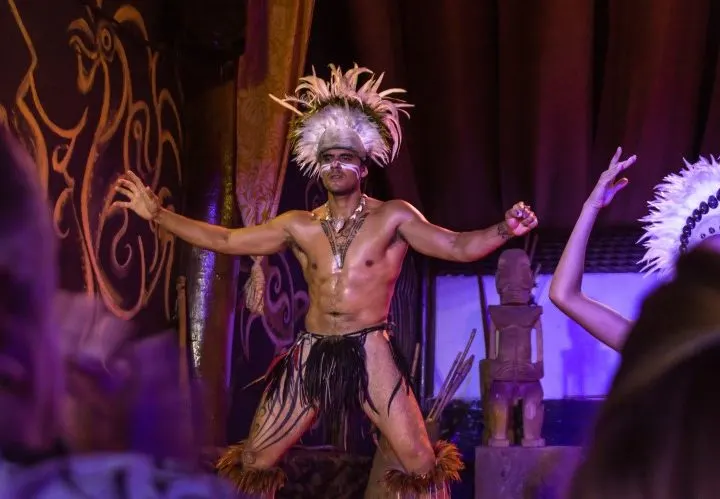
This festival is perhaps the ultimate display of Rapanui culture, with a representative of each family competing in different challenges, from physically demanding displays of skill to craftwork and dancing.
The second-to-last day of the competition sees all of the competing participants, their families, and even tourists join a parade through the streets of Hanga Roa, where all are dressed in traditional costumes and accompanied by Rapanui music and dancing.
The culmination of the events takes place on the final day when the two winners of the preceding activities are coronated the King and Queen of Tapati.
However, these two weeks might not exactly be the best time to go to Easter Island.
Why?
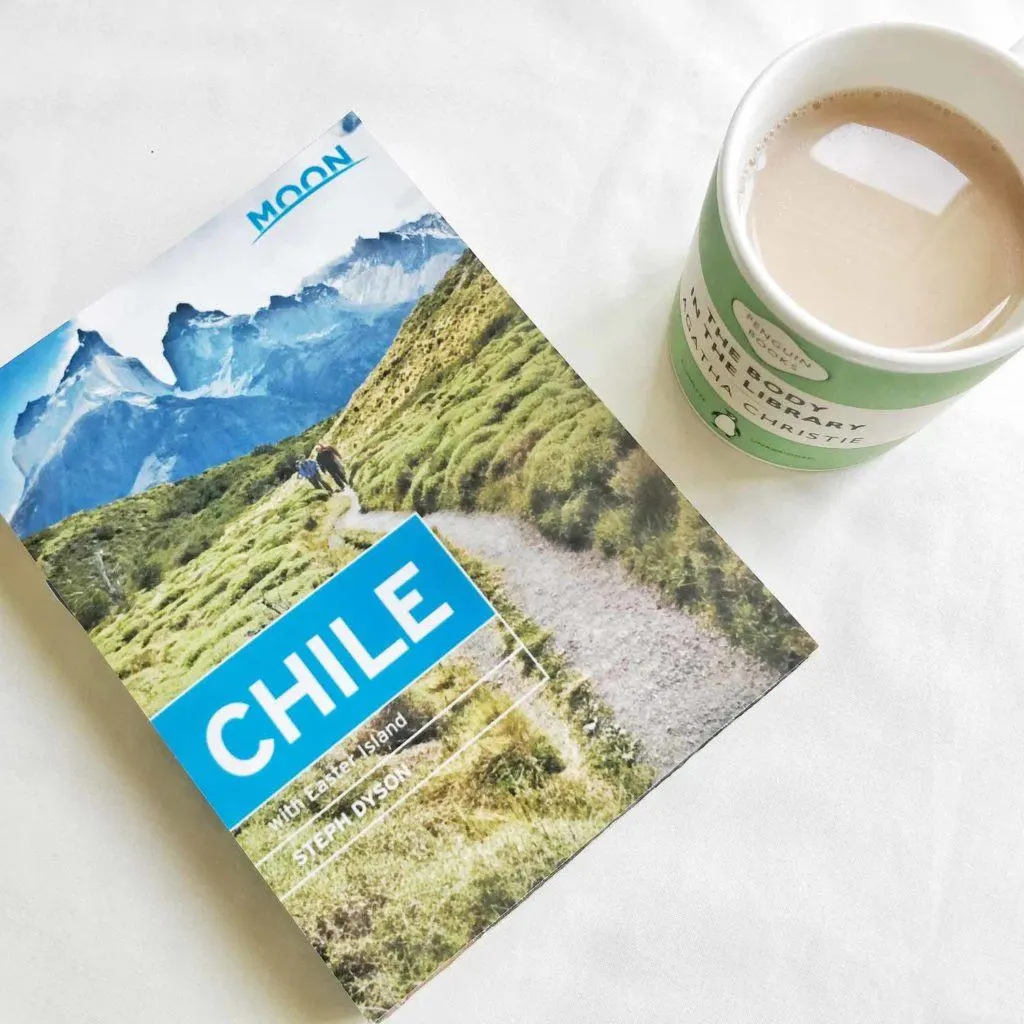
Need more inspiration?
You’ll find even more detailed itineraries, off-the-beaten-path gems, hiking routes and accommodation, restaurant and tour recommendations to suit your travel style in my brand-new guidebook, Moon Chile.
Well, firstly, you can expect flights to increase dramatically for this period and you’ll need to be very organized with accommodation and bookings (we’re talking months in advance) if you want a chance to see the festival.
Secondly, I was told by a number of local people that, while it’s certainly a once-in-a-lifetime event, you should expect a lot of the services on the island, such as restaurants and even hotels, to screech to a halt, as families focus on the competition in hand.
Although the island is still functioning, expect everything to be a bit disorganized.
Finally, when visiting the island’s most acclaimed sights, you’ll be sharing the moment with thousands of others. Visitor numbers reach up to 20,000 over this period.
Traffic around Hanga Roa and even on the roads heading out to the main moai sites can be a real problem because of the sheer number of people and cars, so you can expect extreme congestion when you’re driving.
So when is the best time of year to visit Easter Island?
If you’re keen to see the island at its quietest and get the chance to speak to the local people and see daily life here, I recommend September and October or April and May.
Both of these periods still have good weather, warm temperatures (around 22˚C-25˚C), and relatively few tourists.
While the peak summer months are good for sunbathing at Anakena beach, if you fancy hiking or any sort of exploration, you’ll find it tough to do it thanks to the island’s humidity, even if the sea breezes bring welcome reprieve.
Get more in-depth information in this guide to the best time to visit Easter Island.
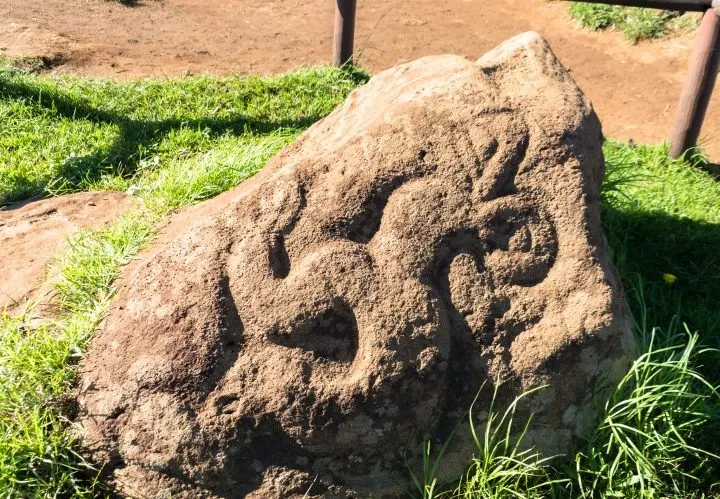
I went to Easter Island in June and enjoyed the quietness of the place but found that there was a fair amount of rain; showers are common most days so if you plan on taking photos, you might be disappointed with the number of overcast and damp days.
What does an Easter Island trip cost?
The price of a trip to Easter Island varies significantly. I’ll start with a basic overview and then go into detail about the exact prices you can expect to pay for food, transportation, and accommodation on Easter Island.
Overview of how much an Easter Island vacation costs
Most visitors to the island spend between four and five days here, which is plenty of time to see its highlights and really dig beneath the surface of Rapa Nui culture.
The amount of money that you will spend during that period can vary significantly.
Want to avoid the hassle of organizing your accommodation and tours? EcoChile Travel are a brilliant Chilean tour operator and their four-day trip to Easter Island costs from $1,130 USD per person (and you get a 5% discount if you mention Worldly Adventurer when enquiring through this form!).
Note: to visit any of the sights within the national park (i.e. practically all of the moai) you must pay the entrance fee of $63,000 CLP ($80 USD) for adults or $31,000 CLP ($40 USD) for children*. You can buy these online here.
This gives you a window of ten days in which to visit the national park and you can only visit the sites of Rano Raraku and Orongo once during that period.
Bear in mind that because it’s now obligatory to visit practically all of the archaeological sites with a guide, it’s much more expensive to visit the island.
For a four-night stay for two people in budget accommodation, self-catering except for a few meals out, and going with a local guide to explore the main sights, you can expect to pay:
| Expense | Cost (daily for two people) |
|---|---|
| Cost of mandatory guide | $80 USD (private guide); $360 USD (tour agency) |
| Accommodation | Double room $35,000 CLP ($45 USD)-$59,000 CLP ($74 USD)* |
| Food | $20,000 CLP-$32,000 CLP ($24 USD-$40 USD) |
| Transportation | If you hire a private guide, you will also need your own transport. The cheapest is a Suzuki Jimny for $90,000 CLP ($114 USD) per day |
| Total per day | $119,000 CLP ($149 USD) + $90,000 CLP ($114 USD) for transport |
| National park fee | $126,000 CLP ($160 USD) |
Total for two people for four days (including three full-day guided tours) | $770,000 CLP ($973 USD) + flights |
| *You can reduce this to $16,000 CLP ($20 USD; camping) or $30,000 CLP ($34 USD; dorm) |
For a four-night stay for two people in mid-range accommodation, mostly eating out and going with a local guide to explore the main sights, you can expect to pay:
| Expense | Cost (daily for two people) |
|---|---|
| Cost of mandatory guide | $80 USD (private guide); $360 USD (tour agency) |
| Accommodation | $85,000 CLP – $92,000 CLP ($105 USD – $115 USD) |
| Food | $32,000 CLP ($40 USD – $60 USD) |
| Transportation | If you hire a private guide, you will also need your own transport. The cheapest is a Suzuki Jimny for $90,000 CLP ($114 USD) per day |
| Total per day | $879,000 CLP ($1,095 USD) + $90,000 CLP ($114 USD) for transport |
| National park fee | $126,000 CLP ($160 USD) |
| $962,000 CLP ($1,217 USD) + flights ($1,370,000 ($1,715 USD) + flights if you choose a tour operator, rather than a private guide) |
The following in-depth sections should show how much it costs to go to Easter Island according to each of these categories.
Top Easter Island travel tip: Bring plenty of Chilean pesos in cash. You’ll find that in some hotels, tour agencies, and even restaurants, you end up being charged less if you pay in cash. There are two ATMs on the island but it’s worth stocking up before you go to avoid any issues with money running out, particularly in the high season. Easter Island is very very safe so you shouldn’t worry about bringing cash onto the island.
Food and dining costs on Easter Island
Easter Island is an expensive destination in some respects. Beyond the costs of flying there, food prices are at a premium.
As you can imagine, the island is so far from any other land mass that, aside from what they produce on the island, it all needs to be transported in at a high cost.
Before visiting Easter Island, I’d been recommended to buy food on the mainland in Santiago to take with me.
This is definitely an excellent option for those planning on self-catering and I was queuing for the plane behind a family who had a box full of yogurts as their hand luggage.
I’ve also heard from a range of Chileans that if you take items such as wine, whisky, or pisco with you, these can be used in lieu of payment in some instances (this is not something that I confirmed when I was there so use this strategy at your own risk!).
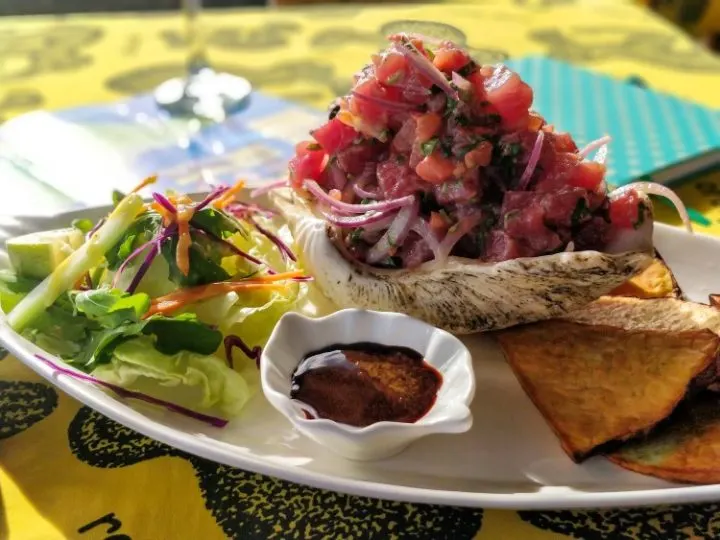
If you want to eat at the restaurants on Easter Island, it’s worth budgeting around $17,500 CLP ($22 USD) per meal in a nice restaurant, although a meal in a picada (a simple, fast food restaurant) can cost less than $12,000 CLP ($15 USD) – Club Sandwich (Calle Atamu Tekena s/n, noon-midnight daily) is one of the best.
There are also some excellent empanadarias, shops selling deep-fried pastry empanadas, filled with tuna and cheese or other fish, that normally cost around $2,400-$5,000 CLP ($3-$6 USD).
Top Easter Island travel tip: Check out the empanadas at Ahi-Ahi (Calle Policarpo Torre, 10am-9pm daily), one of the wooden shacks on the southern side of the football field. They were easily the best I tried during my trip. For top-quality dining at only marginally more expensive prices than in most other restaurants, head to Kaloa (inside Hangaroa Eco Village & Spa, Av. Pont s/n, 18.30pm-22.30pm daily). Dishes cost between $14,000 CLP and $18,000 CLP ($18 USD and $22 USD), which is about the same price as most restaurants on the island, but the quality is exceptional. Make sure to sample their tuna dishes.
Transportation costs and getting around Easter Island
Easter Island transportation is another cost. Getting around Hanga Roa – the only town on the island – is straightforward and you rarely need to get a taxi as it’s so compact.
However, visiting the ahu, moai and other historic attractions around the island is another matter.
I took a range of tours on the island; however, I personally found that my preferred way of exploring was in my own vehicle. There are so sights and most tour companies only visit the most famous or picturesque.
With your own vehicle, you can choose the time of day to venture to each different place and be far more in control of your own schedule.
I found that tours often went at a slower pace than I would have liked and that being able to drive at will allowed me to see far more than I would have been able to if I had purely been exploring via a tour.
If you’re traveling in a group or as a pair, renting a car also makes financial sense as you’ll save plenty of pesos compared with the price of a tour.
However, bear in mind that, as of August 2022, you can only visit most of the sites in Parque Nacional Rapa Nui (except Ahu Tahai, near Hanga Roa, and Anakena Beach) with a licensed guide.
IMPORTANT NOTE: As of August 2022, you can only visit Parque Nacional Rapa Nui with a licensed guide. This is the case for all sites except Ahu Tahai (near Hanga Roa) and Anakena Beach (in the north of the island). You can find a list of licensed guides on the island here (which start from around $40 USD per day per person for an English-speaking guide without transport included), while Easter Island Travel are one of the island’s tour agencies, run tours that include transport with a maximum of eight passengers, and have guides that speak good English.
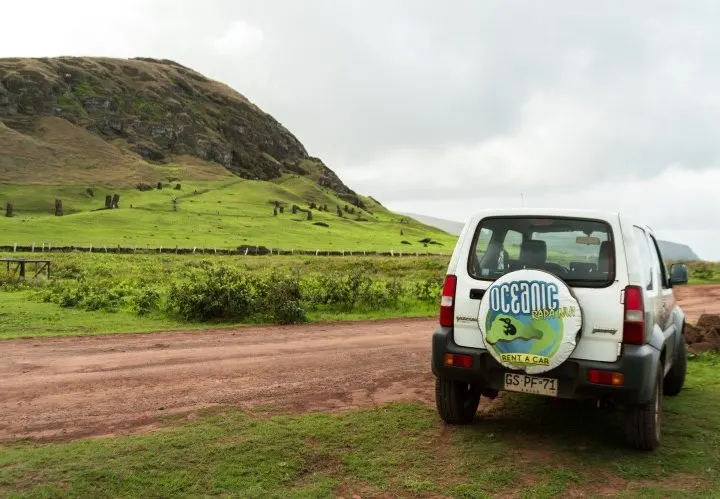
I rented a car with Oceanic Rapa Nui, who unfortunately closed during the pandemic. Insular Rent a Car is the only car rental company that I believe is now operating on the island.
Given how small the distances were (the island is only 22.5 kilometers long by 11 kilometers wide), I spent around $20,000 CLP ($30 USD) on petrol – and I pretty much covered all of the roads at least once.
Depending on how much you wish to spend on your transport, you will find several types of vehicles including four-seater Suzuki Jimny for $90,000 CLP ($115 USD) and five-seater Suzuki Alto K10 AND Celerio for $90,000 CLP ($115 USD), Daihatsu Terios Wild for $140,000 CLP ($178 USD) and Toyota Hilux for $150,000 CLP ($190 USD). You can also hire various scooters and motorbikes for upwards of $40,000 CLP ($51 USD) per day, plus Kawasaki quadbikes for $75,000 CLP ($95 USD).
You can rent out mountain bikes for $35,000 CLP ($44 USD) per 24 hours.
Although distances are small, given how hot and humid it gets (it is a Polynesian island, after all), cycling in this weather can be somewhat unpleasant.
Be aware that the road conditions are also dreadful on the island. It’s not recommended to drive faster than 60 k/ph in case you come across a pothole (very likely) or free-range horses (just as likely) on the road.
Vehicle rental has historically not included insurance (so if you crash, you’ll be paying a lot). Double-check this when you hire the vehicle – and take extra care on the roads!
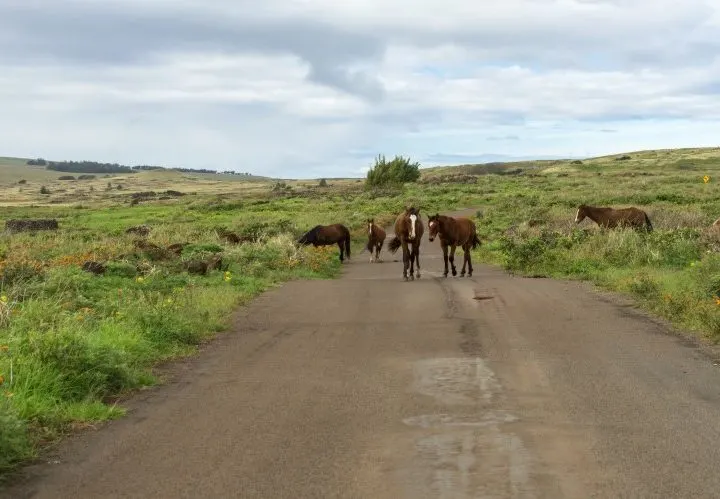
Top Easter Island travel tip: Rent a car in the afternoon so that you can drive to see the sunset at Ahu Tahai or at Hanga Piko or Hanga Kio’e (two lesser-visited spots for beautiful sunset views) and get up early the next morning to drive to Ahu Tongariki for the sunrise. Insular Rent a Car is the only car rental company that I believe is now operating on the island. Remember: you will need a licensed guide to come with you, so rent a vehicle that has enough space!
Accommodation costs and where to stay on Easter Island
Accommodation on Easter Island can also be costly. However, there is a range of lodgings to suit all budgets and plenty of places to stay in Easter Island.
Since August 2018, a law has dictated that unless you have proof of accommodation reservations with lodgings registered with the island’s tourist board, you won’t be allowed to board your flight in Santiago. You can also only stay on the island for up to 30 days.
The LATAM website has the list of what you require (in English!), including access to the entry form you are required to complete before you fly; a confirmation email will be sent to you that you must present when you are at the airport.
Note that all prices included here are for Easter Island hotels in January/February, the most expensive season, when you’ll need to book well in advance for all accommodation.
Outside of these months, you can expect to pay up to 10% lower on the prices listed below.
Budget accommodation and hostels on Easter Island
One of the cheapest and consistently good budget options on Easter Island and the place for camping on Isla de Pascua is Mihínoa Camping (Av. Pont s/n, double $35,000 CLP ($54 USD), dorm $15,000 CLP ($23 USD), rent camping equipment $10,000 CLP ($15 USD), camping with your own equipment ($12 USD)).
I was really impressed with their three large kitchens and array of different accommodation options: there is grass for camping, dorm rooms, and private rooms available. The campground also has a lovely view of the ocean.
Be aware that this place gets booked up very quickly, particularly between January and March, so you’ll need to make reservations well in advance.
La Casa del Kori (Calle Paoa s/n, double private bath $59,000 CLP ($86 USD), dorm $20,000 CLP ($30 USD)) was my favorite budget accommodation on the island. It has superb, modern facilities, ranging from large double bedrooms to equally spacious dorm rooms (the latter with lockers) and loads of communal space in the downstairs kitchen and living areas.
Breakfast is included and the owners speak English.
Mid-range accommodation and hotels on Easter Island
With large, airy bedrooms and surprisingly good Wifi (most places on the island have terrible connection!), Inaki Uhi Hotel ($180 USD double) is an incredibly welcoming hotel, with a cozy garden, modern facilities, and really helpful hosts.
The stunning sea views from certain suites and bungalows make Hotel Boutique La Perouse ($210 USD suite; $288 bungalow) an excellent choice for accommodation on Easter Island. Situated right at the heart of Hanga Roa, but with a tranquil setting, this is a great place to relax after a day of touring the island.
I was really impressed by the facilities at Hareswiss (Calle Te Hoe Manu s/n, double cabin $92,000 CLP ($140 USD), single occupancy of cabin $65,000 CLP ($99 USD), who have three well-equipped cabins overlooking the sea, about a 25-minute walk (or $3,000 CLP ($4.50 USD) taxi journey) from Caleta Hanga Roa, the main part of the town.
Peter, the Swiss expat who runs the cabins, is also exceptionally friendly and knowledgeable about the island and often runs tours if you contact him in advance.
Luxury accommodations and hotels on Easter Island
Located within easy walking distance of the main road in Hanga Roa, where you’ll find a glut of restaurants, Hare Nua Hotel Boutique ($360 USD double) is a really comfortable, family-run hotel with large bedrooms, many of which have balconies, as well as a swimming pool and gorgeous communal lounge area where you can catch a sea breeze.
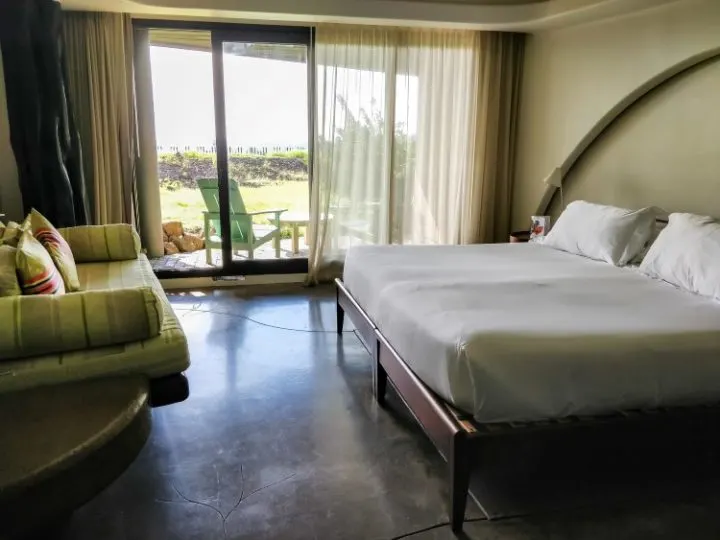
A standout hotel on Easter Island is the Nayara Hangaroa (Av. Pont s/n, $470 USD double standard, $605 USD double suite), a five-star resort with swimming pools and spa facilities, an on-site restaurant (with divine food) and huge bedrooms with designer stone bathtubs and decorative touches to make them blend seamlessly into their surroundings.
They also run excursions around the island.
Should you take a tour of Easter Island?
As I’ve indicated above, I personally preferred my time exploring without a tour and instead using a rental car. However, the situation has now changed on Easter Island, meaning it’s obligatory to enter the national park accompanied by a guide.
Going with a guide did allow me to understand much more about the island, its history, and historic sites, as practically all guides are Rapanui and therefore very proud and aware of their heritage. You can now choose whether to hire a guide (you can find them listed here and they start from $40 USD per person, per day for an English-speaking guide, excluding transport) and drive yourself, or book a tour with a local operator.
I recommend Easter Island Travel, who are an affordable choice for tours. They take you to the main archaeological sites (from $145,000 CLP ($180 USD)), as well as various other hiking tours.
A more expensive option is Green Island Tours, who have a whole host of different tours, including trips to visit the key archaeological sites across the island (from $320 USD), as well as hiking tours to explore some of the lesser-visited destinations (from $320 USD) and even stargazing (from $90 USD).
Both include transport.
If you want to avoid the hassle of organizing your accommodation and tours, EcoChile Travel are a brilliant Chilean tour operator, whose four-day trip to Easter Island starts from $1,130 USD per person (and you get a 5% discount if you mention Worldly Adventurer when enquiring through this form!).
I was told that the best Easter Island tours to take were to Orongo on the far southern point of the island, the remains of the ceremonial stone village where the Birdman competition was held, and to Rano Raraku, the quarry where the moai were carved.
I personally found that with Orongo, the visitor’s center has plenty of information in both Spanish and English and I didn’t feel I learned much more by having a guide.
However, my trip to Rano Raraku was hugely enhanced by the enthusiasm of my guide and you’ll be surprised by how many of the around four hundred moai remain in the quarry there that’ll you’ll miss if you don’t know where to look.
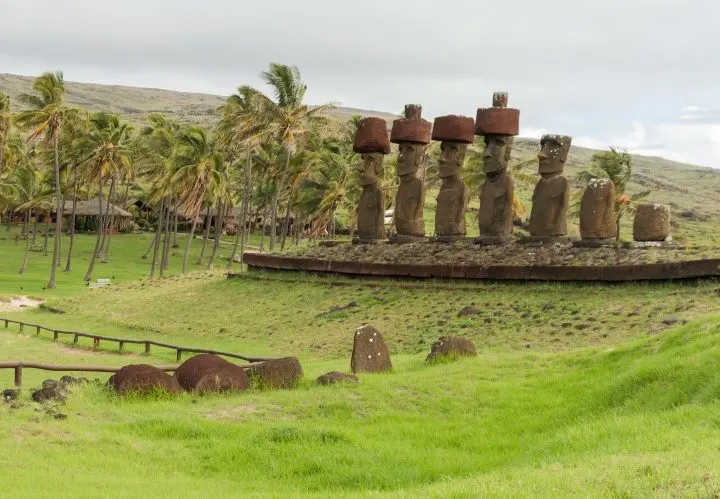
I didn’t get the chance to hike the northern coast of Easter Island, but I was told by plenty of people that it remains a fascinating and largely untouched area filled with moai and other ceremonial structures – and a good place to see Rapa Nui as it really is away from the hordes of tourists.
As there are local people who still inhabit much of the area, it’s also essential to go with a guide to avoid accidentally standing on important historic remains. There are two ways to visit:
- On foot: I recommend Easter Island Travel, who offer this tour for $190,000 CLP ($235 USD) per person, with around six hours of hiking.
- On horseback: I recommend Cabalgatas Pantu. They operate a full-day tour along the coast for $99,000 CLP per person ($125 USD) – or $65,000 CLP ($100 USD) if you pay in cash.
Top Easter Island travel tip: Don’t be afraid to chat with the park rangers who stamp your ticket when you visit the different sights. I found them all to be really friendly and forthcoming when it came to information about the moai and ahu and any questions that I had. Admittedly I spoke to them in Spanish but most speak at least some English.
What to pack for a trip to Easter Island
To ensure you’re prepared for your adventure, make sure you pack the following:
- Reef-safe suncream
- Hat
- Insect repellent: You’ll want to purchase one that contains 20-30% DEET as dengue cases are occasionally reported
- Long-sleeved tops: You’ll ideally want light color, lightweight and easy-drying long-sleeved tops, keeping you cool in the humidity.
- Long trousers: Stay away from the jeans and pick up a couple of pairs of hiking trousers – especially the quick-drying variety. prAna make some brilliantly durable women’s trousers, while Columbia have great options for men.
- Hiking boots: There’s nothing worse than blisters stopping you in your tracks, which is why I live by Salomons. Made of Gore-Tex, they keep my feet dry on hikes and are a lot lighter than those made from heavier leather. It’s worth trying them on in a shop before you buy online – so take the socks you’ll be wearing with you, and work out your accurate sizing in-store. When you’re ready, pick up your Salomons here:
- For her: REI|Backcountry|Amazon
- For him: REI|Backcountry|Amazon
They also do hiking shoes:
(And don’t forget to wear your boots a few times before you head to Rapa Nui to break them).
- Swimming costume: With beautiful clear water surrounding the island, there are plenty of opportunities for swimming when visiting Rapa Nui – make sure you pack at least one swimming costume so you can make the most out of it.
Health and safety precautions when visiting Easter Island
Vaccinations and health precautions
In order to enter Rapa Nui, visitors must be able to show they received the complete Covid-19 vaccination course upon arrival.
While these are technically the only mandatory vaccinations you must receive before entering the island, the CDC and WHO also recommend the following:
- Hepatitis A
- Hepatitis B
- Typhoid
- Measles, Mumps and Rubella (MMR)
Further information can be found here.
Dengue and Zika are also transmitted via mosquito bites, so consider using insect repellent, wearing long-sleeved/leg clothing, and sleeping under a mosquito net.
Safety precautions
The crime rate on Rapa Nui is low, and crimes against tourists are pretty much unheard of. But despite it being generally a very safe place to visit, as with anywhere, it’s wise to exercise common sense, be aware of your surroundings, and not leave valuables unattended.
With little street lighting at night, while it’s typically safe to walk around in the dark, pack a flashlight to help you find your way back to your accommodation to avoid any falls.
Local Etiquette
For a warmer welcome from locals, refer to the island as Rapa Nui rather than Easter Island – and absolutely do not touch any of the moai dotted around the landscape. Not only is it frowned upon, but it’s actually illegal, and could land you with a hefty fine.
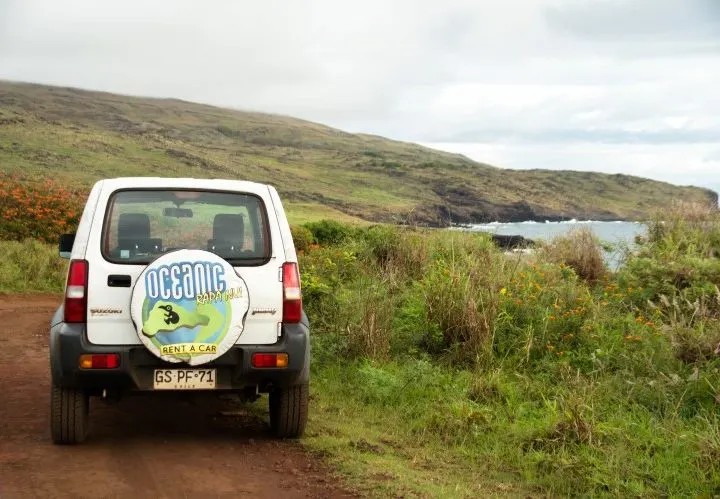
When visiting the Rapa Nui National Park, be sure to keep to the trails, and do not smoke. Drones are not allowed, and take your rubbish home with you.
Ultimately, the moai sites are sacred, and should be treated as such.
Language
The mother tongue of Rapa Nui is known as Rapa Nui – but the Polynesian-based language has only 3000 speakers worldwide (mostly based on the island).
Spanish is the more commonly spoken language, and it goes a long way with locals so make sure to learn a few key phrases before your trip.
Useful general information about traveling to Easter Island
Which currency does Easter Island use?
Easter Island uses the Chilean peso. You can exchange dollars and euros at BancoEstado (Tu’u Maheke, 9am-2pm Mon-Fri) and Santander (Policarpo Toro s/n, 9am-1pm Mon-Fri). Rates will, unsurprisingly, be better in Santiago than here.
How can you visit Rapa Nui National Park?
Most of the island’s sights are found within the Rapa Nui National Park and if you want to visit most of the moai or locations such as Orongo (where the Birdman festival was held), Ahu Tongariki (the platform containing the largest number of moai) or Rano Raraku (the quarry where the moai were carved), you will need to pay the entrance fee.
This costs $63,000 CLP ($80 USD) and can be paid for either at the booth just inside the airport terminal or along Atamu Tekena* in Hanga Roa (a few doors south of the Santa Cruz pharmacy) before attempting to enter any sites.
*When I visited, it was only possible to pay this in cash.
What is Easter Island food like?
Easter Island or Rapanui food is characteristically full of tuna – historically one of the main fish found in the surrounding waters – and used in everything from empanadas to ceviche.
You’ll also find Umu Rapa Nui or Easter Island curanto, a traditional dish of meat, chicken, or fish, wrapped in banana leaves and cooked over hot stones.
This dish is hard to find on the island; Hotel Vai Moana has fire pits on the grounds of the hotel and runs workshops where you can take part in marking and eating a curanto with local chefs.
How can you get from Easter Island’s airport to your accommodation?
Most of the hotels, hostels and even campgrounds on the island offer airport pick-ups – often for no extra cost. Confirm this when you book as, depending on where you’re staying, it can be a long walk from the airport.
How easy is it to get around on Rapa Nui?
None of the hotels or restaurants have street numbers (s/n means “sin number” or “without number”) so it can be difficult to find places, particularly as the majority of the accommodations don’t have signs and locations on Google Maps can be occasionally incorrect. It’s easy enough to ask local people for directions.
Is it easy to get to Easter Island?
Easter Island is located 3,746 kilometers west of Chile and takes six hours from Santiago, with flights leaving from the Chilean capital almost every day. These flights tend to cost from $500 USD return during low season (May through October) and over $1,200 USD return in high season (September through April). As a result, it isn’t particularly easy – nor cheap – to get to Easter Island, but it’s completely worth it!
Most visitors add a four or five-day trip to Easter Island to their Chilean itinerary, as flights from Santiago are almost the only way to get to the island.
How much does it cost to get to Easter Island?
Easter Island is an expensive destination to visit. Flights can cost from $500 USD return per person, although they can cost from $1,200 USD if you’re visiting between September and April, the island’s high season.
In total, for a four-night stay for two people in budget accommodation, self-catering except for a few meals out, and going with a local tour operator to explore the main sights, you can expect to pay at least $1,430 USD plus flights.
Is Easter Island worth the trip?
Yes! Easter Island was a destination that really surprised me. The island’s moai and other archaeological sites dotted around the island are a fascinating insight into the Rapa Nui culture that still exists today.
It’s worth spending four or five days on the island to visit the main archeological sites, including Ahu Tongariki for sunrise and Rano Raraku, the quarry where the moai were carved. I would also recommend seeing a traditional Rapa Nui dance evening, as well as sampling the island’s cuisine, which typically features plenty of seafood.
Which airport do you fly into for Easter Island?
Easter Island has only one airport, Aeropuerto Internacional Mataveri de Isla de Pascua (IPC). It is situated less than a kilometer from Hanga Roa, the island’s only town, and offers incredible views of the island and surrounding ocean as you land on the runway.
Flights depart from the Chilean capital, Santiago, a few times per week, and pre-Covid 19, there were also weekly flights from Papeete (Tahiti) in French Polynesia.
Conclusion
With beautifully clear waters, an incredibly low crime rate and hundreds of culturally significant moai to explore, a trip to Rapa Nui is a must for those looking for something a little different from their vacation.
For further information and to start planning your trip, read my posts on the best time to visit Easter Island, and where to stay on Easter Island. Visiting mainland Chile too? Discover some of my favorite places to visit in Chile.
** I’m going to be honest here: I’ve used “Easter Island” because that’s the name that you probably used to find this article in Google. The most politically correct term for the island is Rapa Nui, as it’s the name used by the local inhabitants, not one given by a white guy from Europe who turned up and claimed it for himself. When visiting, be sure to refer to the island as Rapa Nui if you want to have a better reception from the local people who are fiercely proud of their culture and island.
Found this article about visiting Easter Island without spending a fortune useful? Pin it!
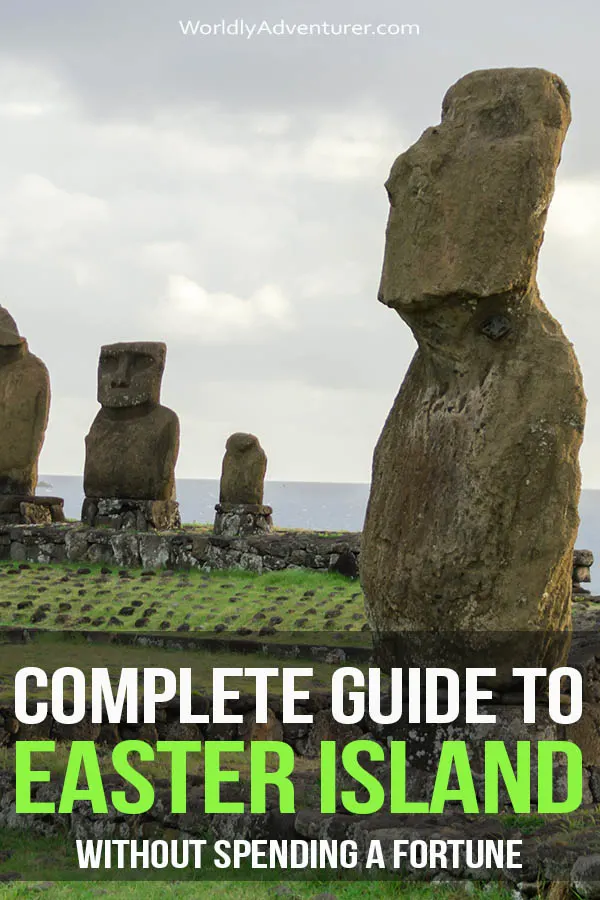

Nicholas
Friday 16th of February 2024
Hey Steph!! Incredible information. Thank you and your team for putting the time/energy/hard work into these in-depth travel guides! My partner and I are looking into adding Rapa Nui to our current Sao Paulo/Rio/Lima/Machu Picchu (all part of a June group excursion for an international business program)15-day adventure. So, we wanted to do something small without the group before heading home since we'll be on that side of the continent and who knows when we'll ever make it back! We're gonna try that LATAM trick with booking through the local version of the site. Seems like using an AMEX should allow for the transaction to process, based on what I've seen in some forums. With the only daily flight from Santiago currently getting into the island around 1p local time, then leaving daily to take folks back at 230p, we were just going to do a Sunday arrival to Tuesday departure. Does that seem to quick of a trip for the highlights? Basically, an afternoon/evening, then a full, then a morning/early afternoon.
Steph Dyson
Wednesday 21st of February 2024
Hi Nicholas, it's not much time at all but I guess if you don't have more time then it'll have to do! It is a six-hour flight though, so if it's somewhere you really want to go then I would suggest coming back and spending more time there. I really is an incredible island! Steph
Pam
Friday 9th of February 2024
Dear Steph,
Thank you so very much for this very well thought out and comprehensive guide. We were very excited to visit Rapa Nui for 5 full days and can comfortably afford the costs. However, we were very disappointed to learn that we pretty much can't go anywhere without a guide. I had envisioned leisurely and quiet strolls carefully respecting the rules of visiting the moai,(I am an archaeologist) but at my own pace and if I wanted to sit on the beach vegetating for an hour or two, that kind of relaxation sounds impossible with a guide. Also, when we are in a magical place like we would have found in Rapa Nui, sometimes we don't talk for hours. We have traveled the world and are always independent tourists.
That doesn't mean that I wouldn't want to hire a person for a day or two to learn of the history and to understand what these statues mean to the indigenous people. It was also distressing to learn that some sites can only be visited once.
Therefore, we have decided to spend the time exploring more islands in Indonesia instead. I am sad to let this dream to visit Rapa Nui go, but I just don't want to spend the money and time feeling restrained by a guide's schedule for so many days.
Sadly, Pam
Steph Dyson
Friday 9th of February 2024
Hi Pam, unfortunately it was a decision made by the Rapa Nui people as a way to protect their own heritage and archaeological sites that are still of significant cultural and religious importance to them. I hope you enjoy your time in Indonesia. Steph
Brian
Monday 22nd of January 2024
Thank you so much for this article! Wonderfully helpful. I have a couple of questions. Would 4 days be enough time to experience the island?
Steph Dyson
Friday 9th of February 2024
Hi Brian, yes, because you would get two full days. The only issue is the flight schedules, which might not allow you to spend four days there, so just double check! Steph
Panya
Sunday 3rd of December 2023
Hi Steph and world, does anyone have news if the flight connection between Rapa Nui and Tahiti will reopen in 2024? Thanks a ton!
Steph Dyson
Sunday 14th of January 2024
Hi Panya, I have no idea unfortunately! Steph
Michelle
Tuesday 15th of August 2023
Thanks for this! Best post I've read yet (and I've read a bunch!) Getting excited for our trip in a couple months!
Steph Dyson
Wednesday 20th of September 2023
Thanks Michelle! Steph